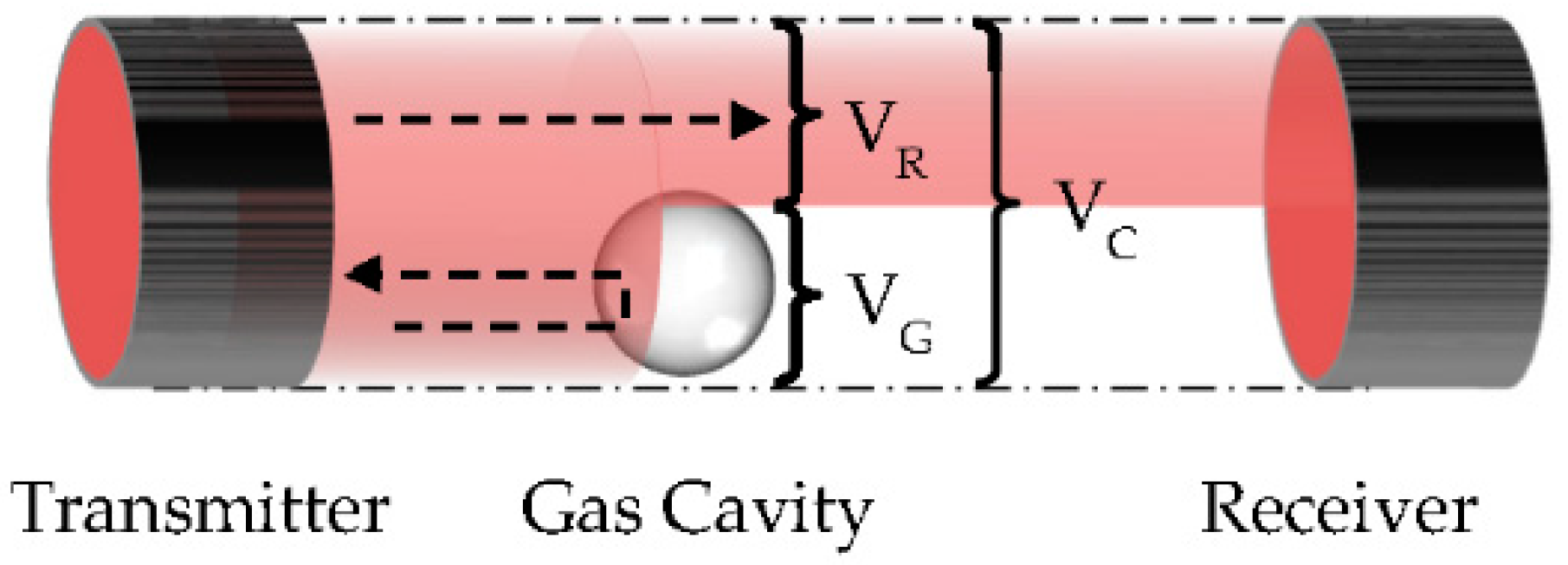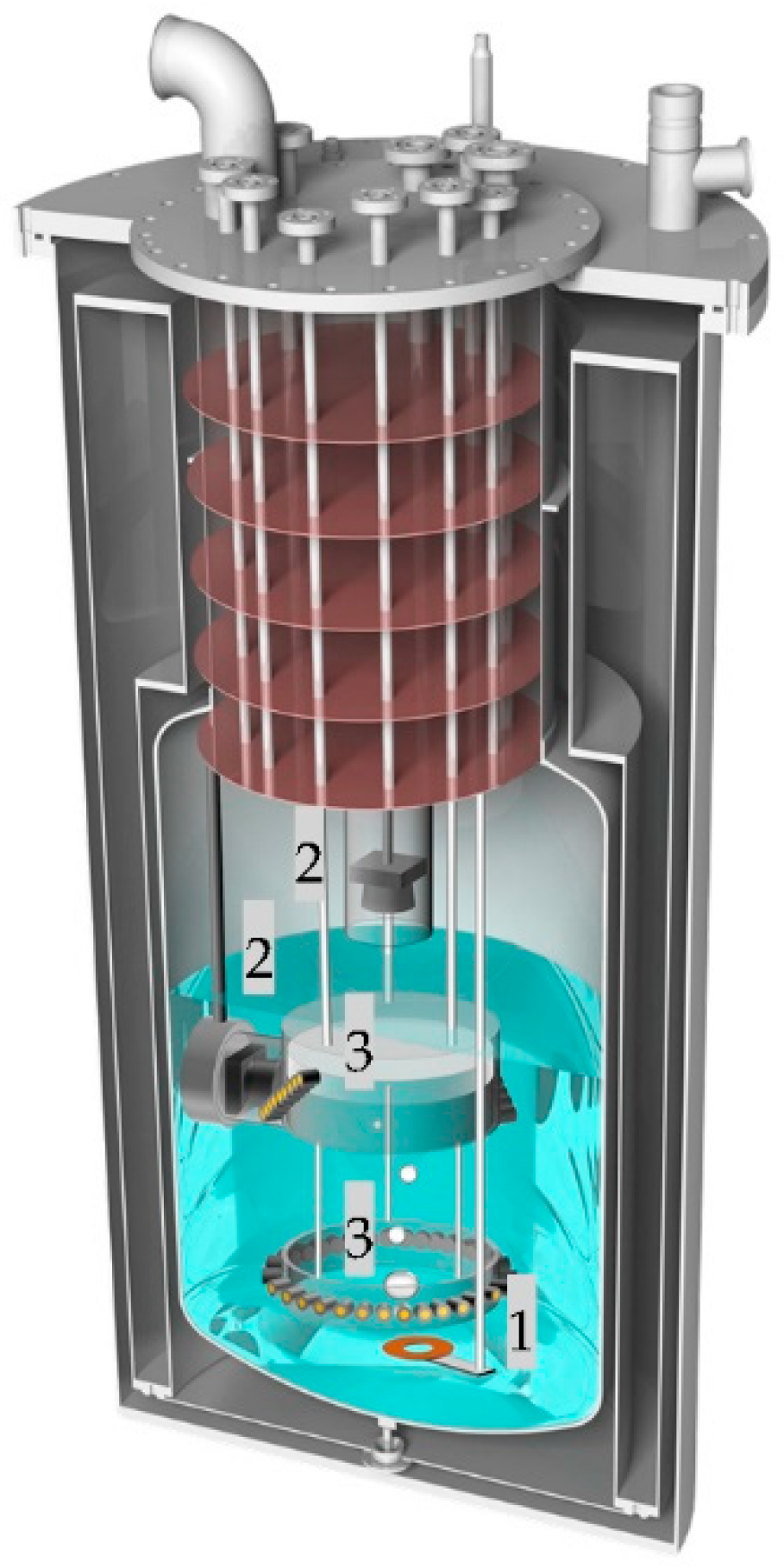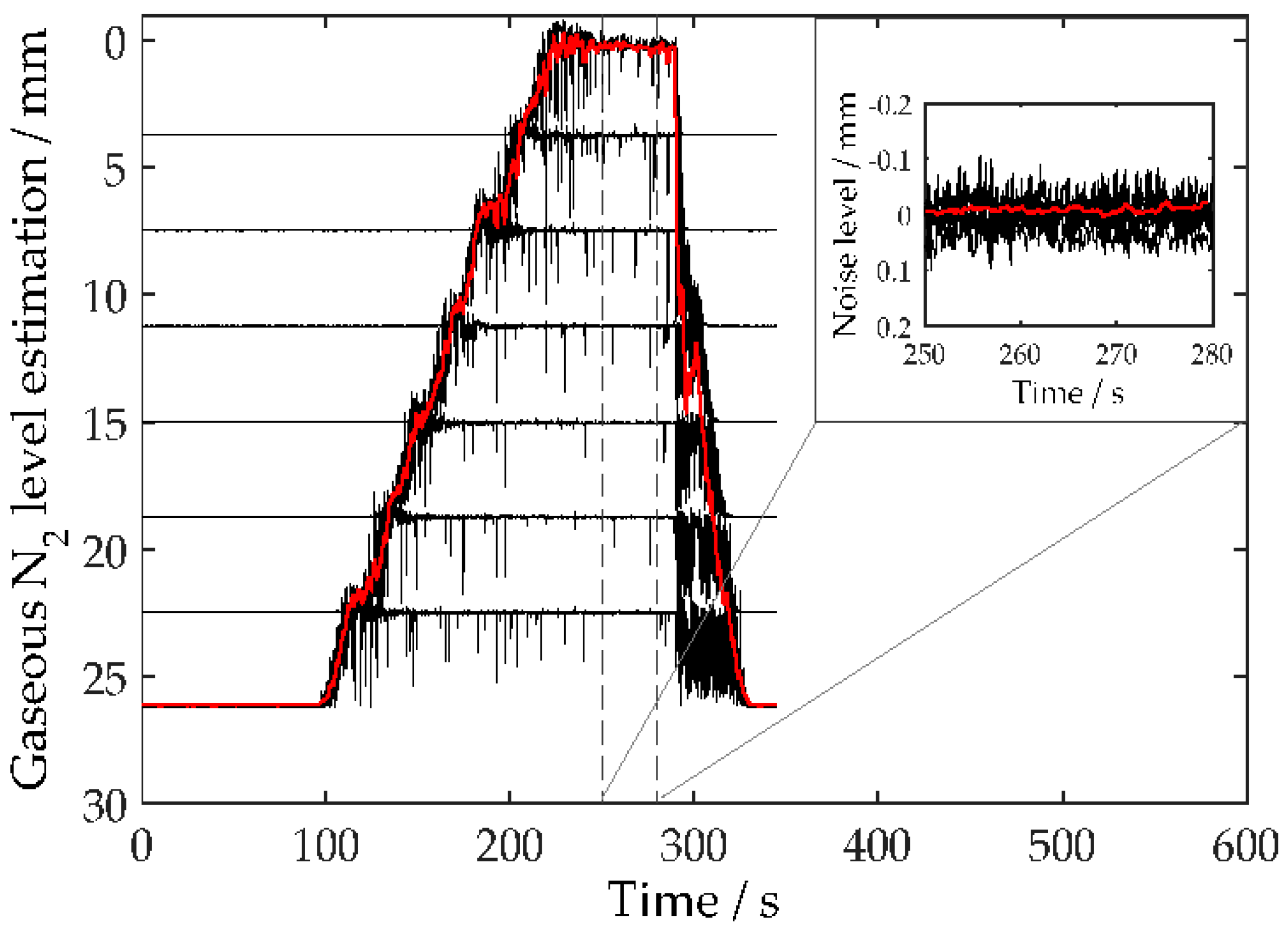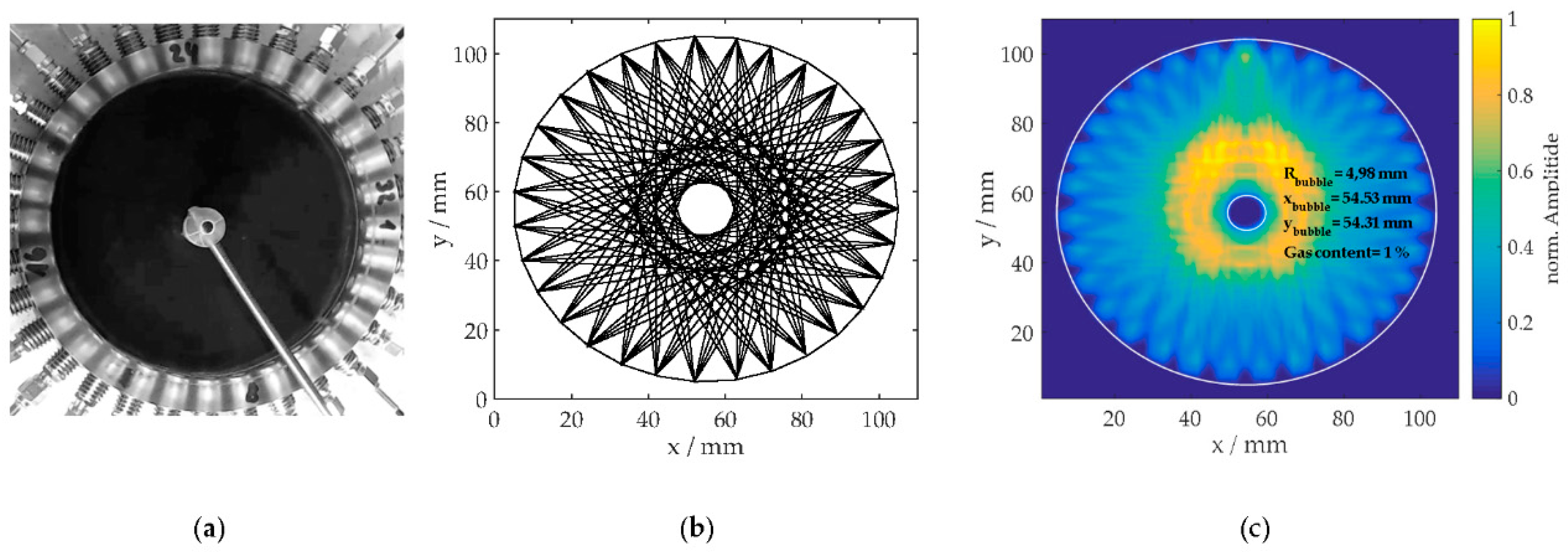Ultrasound Measurement Technique for Validation of Cryogenic Flows †
Abstract
1. Introduction
2. Materials and Methods
2.1. Measurement Concept
2.1.1. Gas-Liquid Level Sensing
2.1.2. Tomographic Bubble Sensing
2.2. Measurement Setup
3. Results and Discussion
4. Conclusions and Outlook
Author Contributions
Acknowledgments
Conflicts of Interest
References
- Siegl, M.; Gerstmann, J.; Fischer, A.; Becker, D.; Schmidt, K.; Lindner, G.; Fischerauer, A.; Kandlbinder, C.; Fischerauer, G. Advanced sensor technologies for cryogenic liquid propellant flow phenomena. In Proceedings of the 66th International Astronautical Congress (IAC2015), Jerusalem, Israel, 12–16 October 2015; pp. 1–7. [Google Scholar]
- Hoyle, B.S.; Xu, L.A. Ultrasonic Sensors. In Process Tomography: Principles, Techniques and Applications; Beck, M.S., Ed.; Elsevier Science: Burlington, MA, USA, 1995; pp. 119–149. [Google Scholar]
- Hoyle, B.S. Process tomography using ultrasonic sensors. Meas. Sci. Technol. 1996, 7, 272–280. [Google Scholar] [CrossRef]
- Wang, M. (Ed.) Industrial Tomography. Systems and Applications; Woodhead Publishing: Cambridge, UK, 2015. [Google Scholar]
- Rahiman, M.H.F.; Rahim, R.A.; Rahim, H.A.; Green, R.G.; Zakaria, Z.; Mohamad, E.J.; Muji, S.Z.M. An evaluation of single plane ultrasonic tomography sensor to reconstruct three-dimensional profiles in chemical bubble column. Sens. Actuators A Phys. 2016, 246, 18–27. [Google Scholar] [CrossRef]
- Pusppanathan, J.; Abdul Rahim, R.; Phang, F.A.; Mohamad, E.J.; Nor Ayob, N.M.; Fazalul Rahiman, M.H.; Kok Seong, C. Single-Plane Dual-Modality Tomography for Multiphase Flow Imaging by Integrating Electrical Capacitance and Ultrasonic Sensors. IEEE Sens. J. 2017, 17, 6368–6377. [Google Scholar] [CrossRef]
- Shaib, M.F.A.; Rahim, R.A.; Muji, S.Z.M. Development of Non-Invasive Ultrasonic Measuring System for Monitoring Multiphase Flow in Liquid Media within Composite Pipeline. IJECE 2017, 7, 3076–3087. [Google Scholar] [CrossRef][Green Version]
- Rahim, H.A.; Barghoshadi, J.A.; Rahim, R.A. Image Reconstruction Technique for the Ultrasonic Tomography System VIA Metal Pipe. Adv. Sci. Lett. 2018, 24, 1406–1410. [Google Scholar] [CrossRef]
- Fazalul Rahiman, M.H.; Abdul, R.; Abdul, H.; Nor Ayob, N.M. Design and Development of Ultrasonic Process Tomography. In Ultrasonic Waves; Santos Junior, A.A.D., Ed.; InTech: London, UK, 2012; pp. 211–226. [Google Scholar]
- Li, W.; Hoyle, B.S. Ultrasonic process tomography using multiple active sensors for maximum real-time performance. Chem. Eng. Sci. 1997, 52, 2161–2170. [Google Scholar] [CrossRef]
- Rahim, R.A.; Rahiman, M.F.; Chan, K.S.; Nawawi, S.W. Non-invasive imaging of liquid/gas flow using ultrasonic transmission-mode tomography. Sens. Actuators A Phys. 2007, 135, 337–345. [Google Scholar] [CrossRef]
- Rahim, R.A.; Rahiman, M.F.; Taib, M.M. Non-invasive ultrasonic tomography: Liquid/gas flow visualization. In Proceedings of the 1st International Conference on Computers, Communications, & Signal Processing with Special Track on Biomedical Engineering, Kuala Lumpur, Malaysia, 14–16 November 2005; pp. 243–247. [Google Scholar]
- NDT Education: Acoustic Properties. Available online: https://www.nde-ed.org/GeneralResources/MaterialProperties/UT/ut_matlprop_index.htm (accessed on 18 July 2018).
- Fazalul Rahiman, M.H.; Abdul Rahim, R.; Fazalul Rahiman, M.H.; Tajjudin, M. Ultrasonic Transmission-Mode Tomography Imaging for Liquid/Gas Two-Phase Flow. IEEE Sens. J. 2006, 6, 1706–1715. [Google Scholar] [CrossRef]
- Ayob, N.M.N.; Yaacob, S.; Zakaria, Z.; Rahiman, M.H.F.; Rahim, R.A.; Manan, M.R. Improving gas component detection of an ultrasonic tomography system for monitoring liquid/gas flow. In Proceedings of the 2010 6th International Colloquium on Signal Processing and Its Applications (CSPA), Mallaca City, Malaysia, 21–23 May 2010; pp. 1–5. [Google Scholar]
- PI Ceramic: Temperature-Dependent Behavior. Available online: http://piceramic.com/piezo-technology/properties-piezo-actuators/temperaturedependence.html (accessed on 18 July 2018).
- Povey, M.J.W. Scattering of Sound. In Ultrasonic Techniques for Fluids Characterization; Elsevier: Amsterdam, The Netherlands, 1997; pp. 91–140. [Google Scholar]






Publisher’s Note: MDPI stays neutral with regard to jurisdictional claims in published maps and institutional affiliations. |
© 2018 by the authors. Licensee MDPI, Basel, Switzerland. This article is an open access article distributed under the terms and conditions of the Creative Commons Attribution (CC BY) license (https://creativecommons.org/licenses/by/4.0/).
Share and Cite
Becker, D.; Schmidt, R.; Lindner, G.; Drese, K.S. Ultrasound Measurement Technique for Validation of Cryogenic Flows. Proceedings 2018, 2, 1090. https://doi.org/10.3390/proceedings2131090
Becker D, Schmidt R, Lindner G, Drese KS. Ultrasound Measurement Technique for Validation of Cryogenic Flows. Proceedings. 2018; 2(13):1090. https://doi.org/10.3390/proceedings2131090
Chicago/Turabian StyleBecker, David, Robert Schmidt, Gerhard Lindner, and Klaus Stefan Drese. 2018. "Ultrasound Measurement Technique for Validation of Cryogenic Flows" Proceedings 2, no. 13: 1090. https://doi.org/10.3390/proceedings2131090
APA StyleBecker, D., Schmidt, R., Lindner, G., & Drese, K. S. (2018). Ultrasound Measurement Technique for Validation of Cryogenic Flows. Proceedings, 2(13), 1090. https://doi.org/10.3390/proceedings2131090





